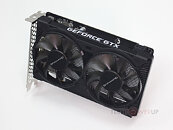- Joined
- Oct 9, 2007
- Messages
- 47,296 (7.53/day)
- Location
- Hyderabad, India
| System Name | RBMK-1000 |
|---|---|
| Processor | AMD Ryzen 7 5700G |
| Motherboard | ASUS ROG Strix B450-E Gaming |
| Cooling | DeepCool Gammax L240 V2 |
| Memory | 2x 8GB G.Skill Sniper X |
| Video Card(s) | Palit GeForce RTX 2080 SUPER GameRock |
| Storage | Western Digital Black NVMe 512GB |
| Display(s) | BenQ 1440p 60 Hz 27-inch |
| Case | Corsair Carbide 100R |
| Audio Device(s) | ASUS SupremeFX S1220A |
| Power Supply | Cooler Master MWE Gold 650W |
| Mouse | ASUS ROG Strix Impact |
| Keyboard | Gamdias Hermes E2 |
| Software | Windows 11 Pro |
NVIDIA today launched the GeForce GTX 1630 entry-level graphics card. A successor to the GT 1030, the new GTX 1630 is an entry-level product, despite its roughly $150 MSRP. It is based on the older "Turing" 16-series graphics architecture, which lacks hardware-accelerated ray tracing or even support for DLSS. It is carved out from the same 12 nm "TU117" silicon as the GTX 1650 from 2019.
The GTX 1630 features exactly half of the 16 streaming multiprocessors present on the TU117. The 8 available SM work out to 512 CUDA cores, 32 TMUs, and 32 ROPs. The card comes with 4 GB as the standard memory size, and this is GDDR6 type, across a 64-bit wide memory bus. The card typically features just two 12 Gbps-rated 16 Gbit GDDR6 chips. The GPU operates at a boost frequency of 1785 MHz. The card lacks hardware-accelerated AV1 decode, and has media features consistent with the rest of the "Turing" family. At $150, it competes with the Radeon RX 6400 (which can be had for as low as $160), and the Arc A380.

Catch the TechPowerUp review of the Gainward GTX 1630 Ghost graphics card.
View at TechPowerUp Main Site
The GTX 1630 features exactly half of the 16 streaming multiprocessors present on the TU117. The 8 available SM work out to 512 CUDA cores, 32 TMUs, and 32 ROPs. The card comes with 4 GB as the standard memory size, and this is GDDR6 type, across a 64-bit wide memory bus. The card typically features just two 12 Gbps-rated 16 Gbit GDDR6 chips. The GPU operates at a boost frequency of 1785 MHz. The card lacks hardware-accelerated AV1 decode, and has media features consistent with the rest of the "Turing" family. At $150, it competes with the Radeon RX 6400 (which can be had for as low as $160), and the Arc A380.

Catch the TechPowerUp review of the Gainward GTX 1630 Ghost graphics card.
View at TechPowerUp Main Site


 ...what? $160? Really?......
...what? $160? Really?......

